Whether hunting or doing some target practice, you will need arrows. But there are so many choices on the market; how do you even begin to choose?
Let’s break this down for you and make choosing arrows for your recurve bow easier. Choosing the perfect arrows for your recurve bows might sound complicated, but it doesn’t have to be.
This guide will provide an in-depth benchmark to help you pick the right type of arrows, especially if you’re a beginner. We’ll talk about what to look for when choosing arrows for recurve bows, how different arrows can affect your performance on the field, and how to choose arrows for recurve bow that fits your needs and budget.
Without any further ado, let’s get started.
Choosing Arrows for Recurve Bows
1. Draw Length Choices
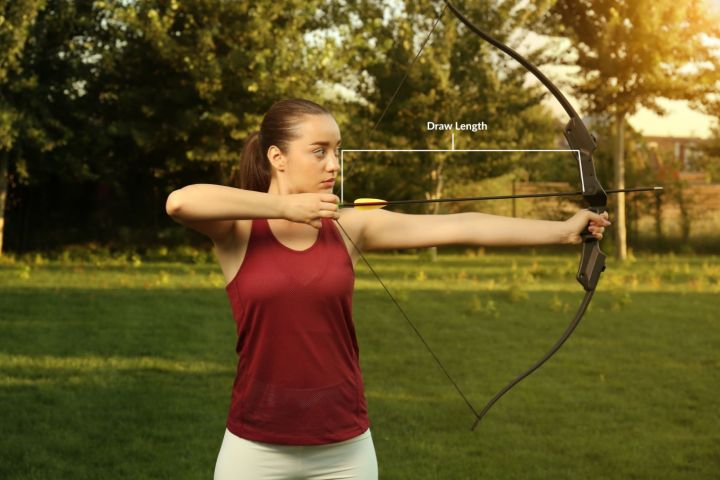
Your draw length is the length from the tip of your middle finger to the side of your mouth. There are two ways this can be measured; they are as follows:
a) Using Your Arm
Spread your arms out to each side, be sure they remain at shoulder height and parallel to the floor. Now, measure across from the tip of your right middle finger to the left middle finger taking the number and dividing by 2.5.
This number is going to be your draw length. The length from my finger to finger is 36 inches. 36 inches divided by 2.5 = 14.4, so my draw length would be 14.4 inches.
b) Using The Wall
Clench your fist facing a wall sideways and place it against the wall. Keeping your elbow stiff, measure from the wall where your fist is resting to the side of your mouth.
This is your draw length (I would be 17 inches using this measure)
To get an exact draw length, take both the wall length and the arm length, add them together, then divide by 2.
This will give you the most accurate draw length. (14.4 +17 = 31.4 divided by 2 = 15.7 inches). My ideal draw weight is 15.7 inches.
2. Choosing a Weight and Diameter
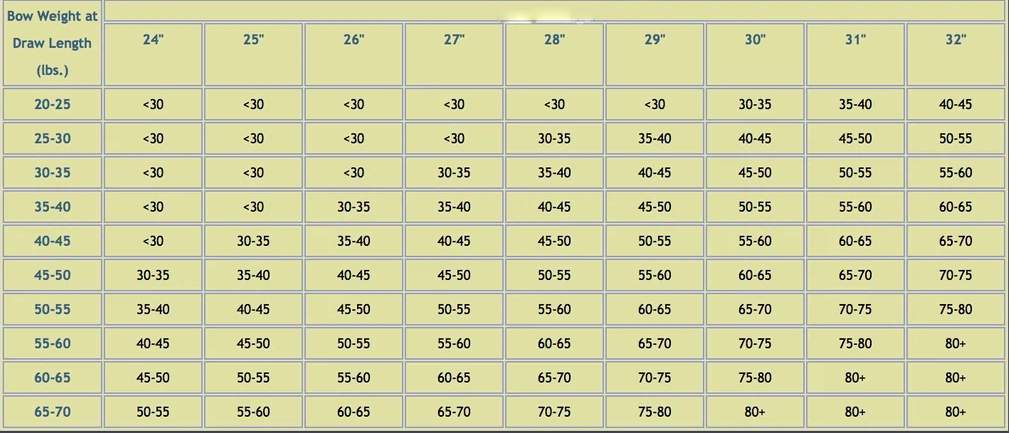
The weight of the arrow is measured in GPI (grains per inch) and is chosen by the weight of your bow. It is calculated by factoring in elements like the arrow’s thickness (the wall thickness), how wide (diameter) the arrow is, and the material the arrow is made from.
3. Length of the Arrow
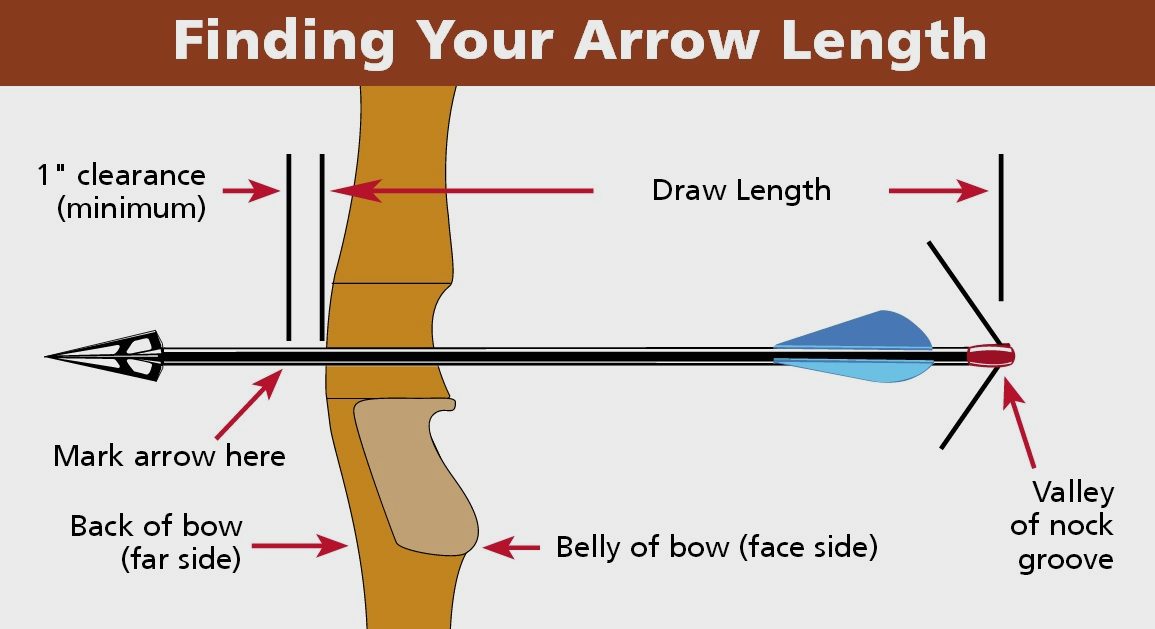
To find the length of the arrow you will need to take your draw length and add 2 inches. (My draw length was 15.7, so my arrow length will be 17.7).
The shorter the arrow, the stiffer it will be. When you order arrows, they will come longer than you want them, have them cut to your preferred size by a professional for safety.
4. Spine Choices
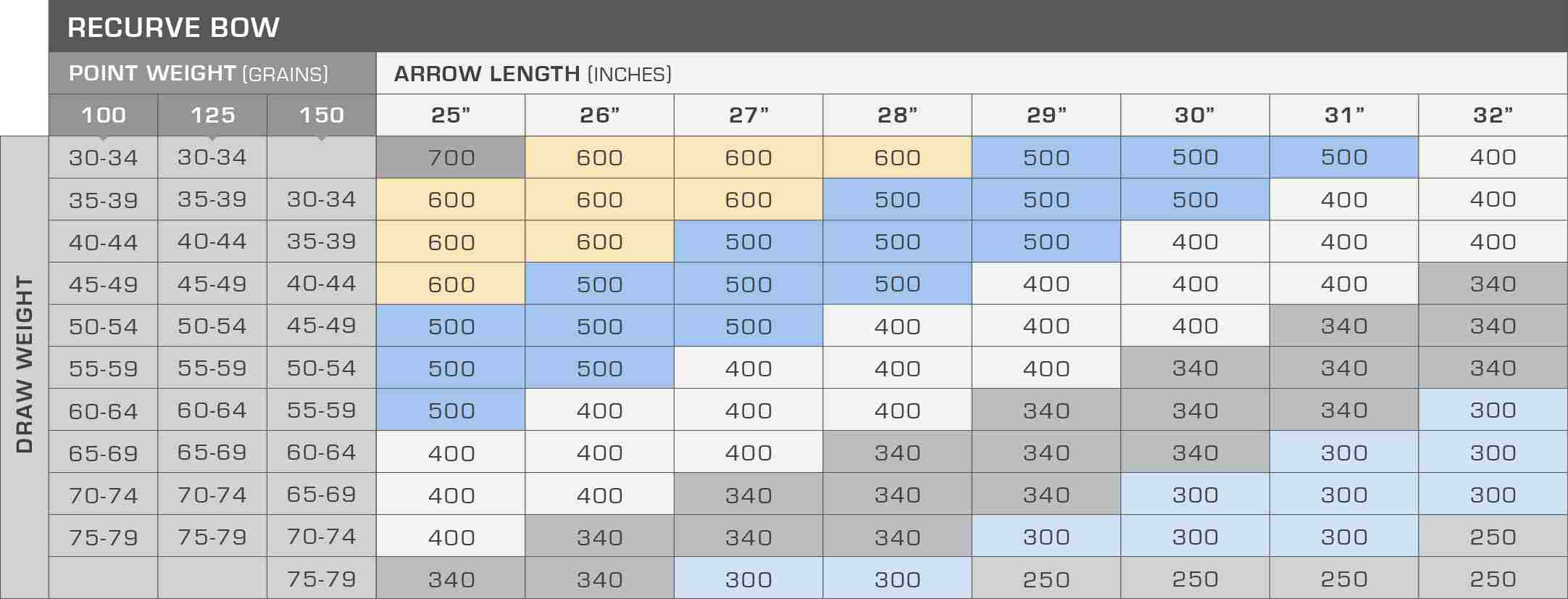
When talking about an arrow’s spine, you are talking about how it moves (wiggles) after being shot from the bow. Always choose the same spine with all your arrows to ensure good groupings.
There are no two identical arrows, no matter who makes the arrows. This is a case of you getting what you pay for; if you buy a cheap set of arrows, they will shoot like a cheap set of arrows.
When choosing your arrows, choose stiff over weak. In general, a stiff arrow will shoot more to the left, whereas a weak arrow will tend to go to the right.
5. Nock Choices
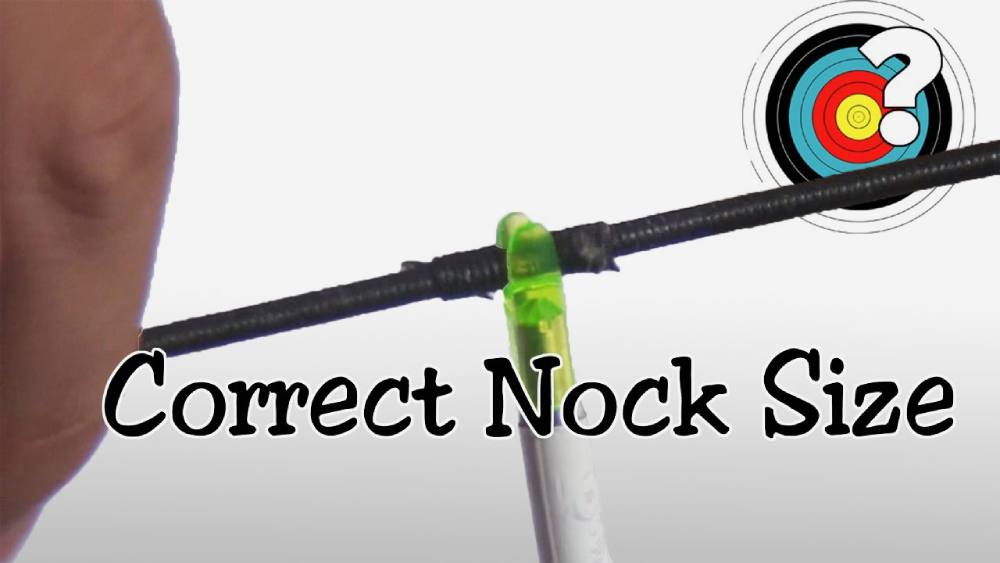
A nock is the anchor point of an arrow that fits on the bowstring and holds it in place. The nock has a small groove that aligns with the string and locks onto it, so you’ll need to ensure your arrows have the nocks that fit your bowstring.
There are four kinds of nocks, conventional nocks, over-fit nocks, pin nocks and press-fit nocks. Let’s explore them one by one.
a) Conventional Nocks or Swages
They have cones made of aluminum and glue in place. They correspond with the arrow’s diameter.
b) Over-fit Nocks
Used on carbon arrows, they slide into place. The manufacturer sets arrow and nock sizes, and matches up by size. For example, if you have a 12X arrow, you should also use a 12X nock.
c) Pin Nocks
These nocks fit over an aluminum pin on the tip end of the arrow. One of the key features of these tips is that they keep the arrow safe from damage when another arrow hits it. Pin nocks come in standard size.
d) Press-fit Nocks
Just like the name suggests, these nocks press in place after being slid into place. They are measured against the arrow’s shaft. Press-fit Nocks are found in the following sizes assigned a diameter: A, F, G, GT, H, HE, and X.
6. Arrowhead or Pointer
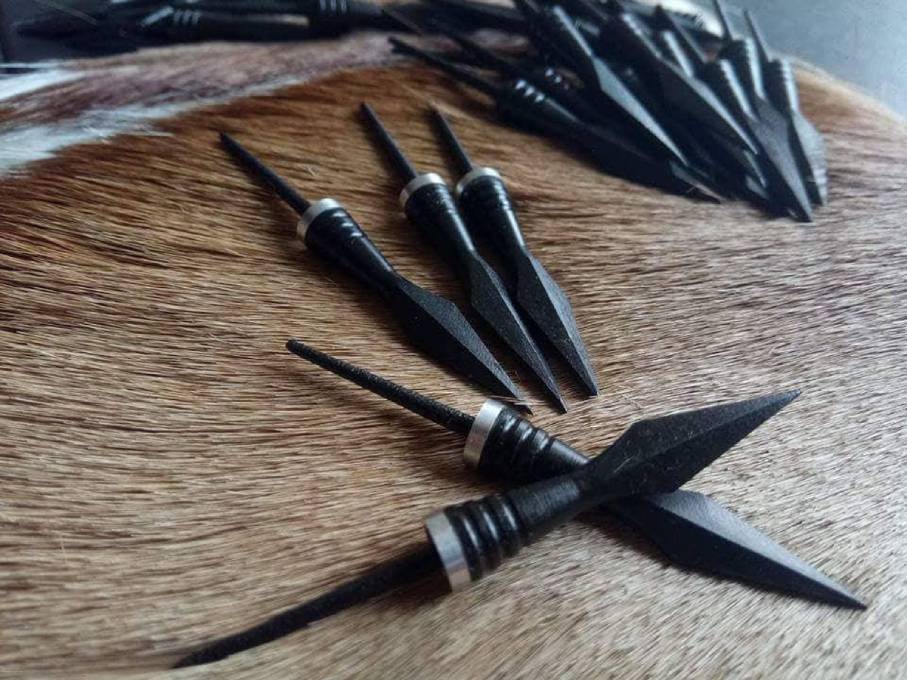
Choosing a tip will depend on your intended purpose. For example, hunters use heavier arrow tips for higher penetration force whereas archers use lighter arrows for greater accuracy.
You’ll want a light tip on a light bow and a heavy tip on a heavier bow for the best shot. If you’re a beginner, you can use arrows that are pre-tipped.
There are three main types of tips used –
a) Broadheads
They have razor blades and are extremely sharp and used for large game hunting (bear, dear, or elk).
b) Field Points
These are usually sharper than bullet points and used for target archery and small game hunting (rabbits).
c) Bullet Points
Sharp but not as sharp as a field point and used at the archery range for target practice or for hunting small game.
d) Blunts Points
Blunts points have a flat tip. These arrowheads are used to kill small game with blunt force but no penetration is involved.
e) Judo Points
These have clasp-like legs on them that grips the prey so the arrow is not lost. They are commonly used for small game hunting, and have flat or blunt tips.
7. Material Choices
Arrows for recurve/compound bows usually are made of four types of materials – aluminum, carbon, fiberglass, and wood. Let’s have a deeper look at what role the materials play in the performance of the best arrows for recurve bows.
a) Composite Arrows
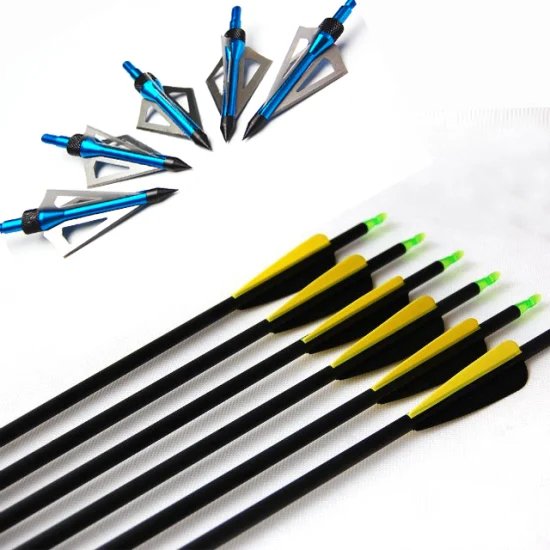
Composite arrows or A/C/Es are high-quality arrows specifically made for higher accuracy. Of all the arrows, they are the straightest, most perfect arrow.
These arrows are expensive, and are used by advanced archers across the globe. However, it’s important to match your arrows with the poundage of your bow as the more your bow and arrow are misaligned, the harder it’ll be to maintain accuracy.
b) Carbon Arrows
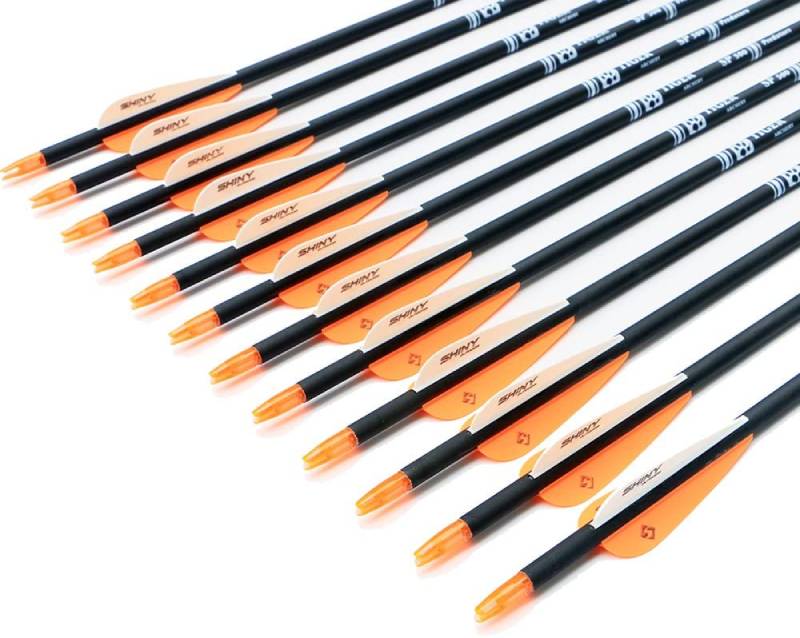
Carbon arrows have less of a curve and are much stronger than wood. They are second only to an aluminum arrow in price.
Pro archers use carbon arrows for their lack of arc (flatter shots with less wind drift.) Every type of arrow gets more or less affected by wind. Carbon arrows keep the effect to a minimum, providing a comparatively flatter trajectory.
However, Carbon arrows are hazardous, as they splinter. If you bend this arrow and hear cracking, do not use it since it could shatter in your hand!
c) Aluminum Arrows
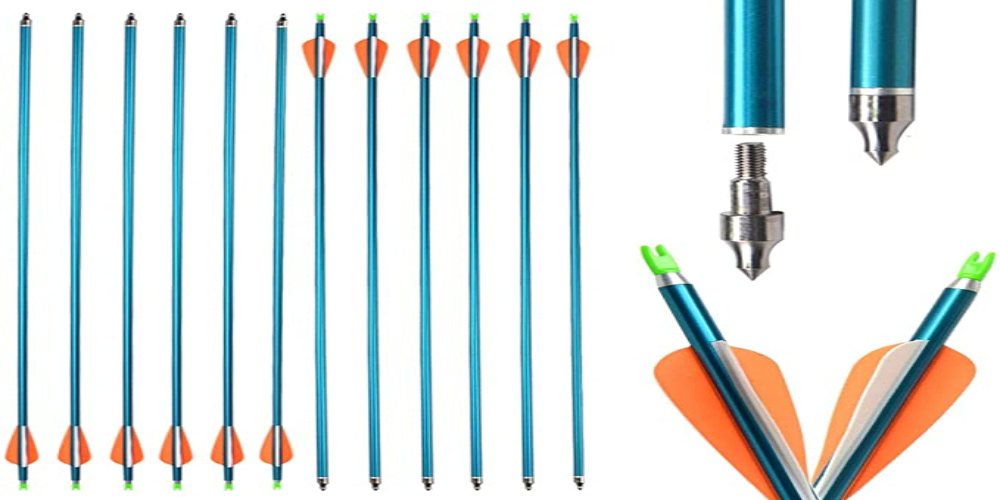
Aluminum arrows are cheaper (some are as low as $6) than most other arrows available on the market. They are lightweight and have good accuracy.
These arrows are most commonly used as recurve hunting arrows. Hunters use them because they are quiet. Their superior flexibility allows them to bend without breaking apart.
d) Wooden Arrows
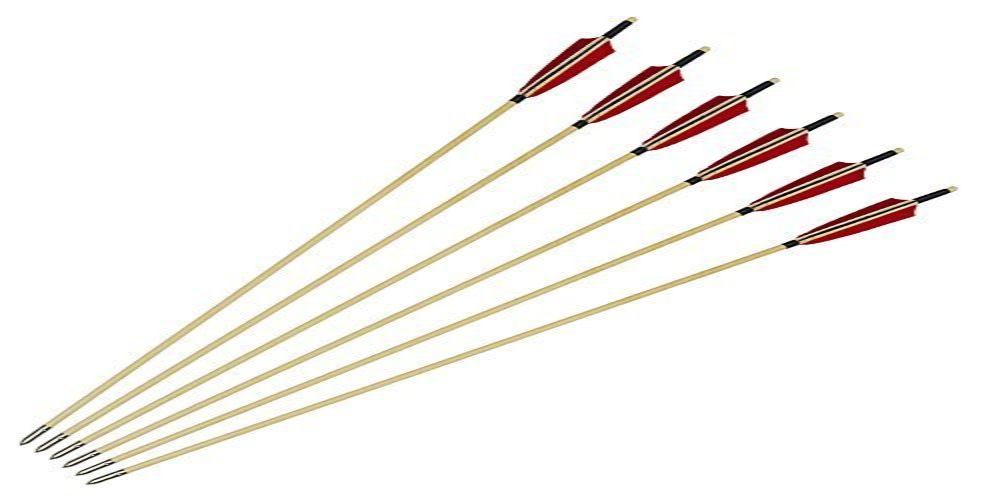
Wooden arrows made from cedar are found in Port Orford Cedar in Oregon, located in the US. These arrows are solid whereas most other types of arrows are hollow inside.
Used in traditional archery, they cost the same as an aluminum arrow. Archers frequently make the tips, fletchings, and nocks for these arrows.
e) Fiberglass Arrows
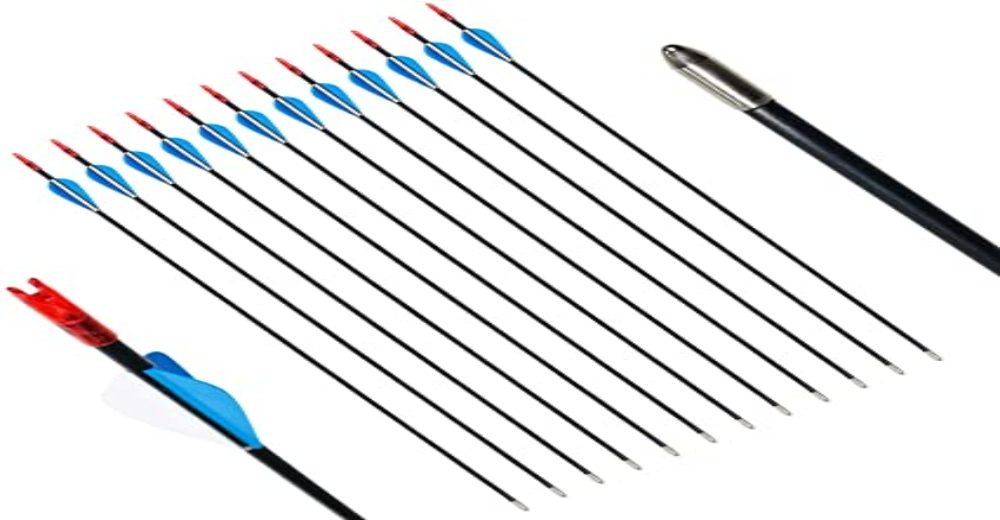
Fiberglass arrows are highly durable. They are the perfect arrow for beginners and young archers. They come in all beginner archery kits.
It is a less accurate arrow because it is heavy but for the young and beginners it is very safe.
Differences in Arrows: Target vs Hunting
Now that you have a clear idea of what to expect when choosing arrows for recurve bows, let’s dive in to explore the difference between hunting and archery arrowheads.
1. Dimension
Hunting arrows are thicker, shorter, and heavier than a target arrows. As a result, they’re also a bit less accurate, especially over long distances.
On the other hand, target arrows are quite thin, light and long. These arrows provide the greatest accuracy and usually come with arrowheads that have a greater surface area to reduce wind drag.
2. Brace Height
When you discuss the belly of the riser grip to the measure of the bow string, you are talking about the brace height.
The brace height is the distance between the bowstring and arrow rest when the bow is at full draw. The shorter a bow’s brace height, the more forgiving and fast it will be with arrows that have greater weight or flexing characteristics.
Hunting bows generally have higher brace heights (7-10 inches) as compared to target bows which have shorter brace heights (5-9 inches). The higher brace height of hunting bows allows it to shoot heavier arrows with more flex.
3. Speed
Speed is vital to hunters for two reasons: it lets them hit the prey before it can move, and the speed of the arrow helps create the force needed for that arrow to impale or penetrate the prey.
Archers don’t worry as much about speed as they do accuracy. Archery arrows are quick but not as fast as a hunting arrow.
4. Shape
The riser on an archer’s bow is straighter than a hunter’s, making the bow’s release much easier on the archer’s hand.
Target arrows are usually straight and long. This helps them to fly more accurately and farther away than hunting arrows do. Hunting arrows, on the other hand, have a greater curve to them which helps them transfer energy quickly while maintaining stability in the air.
5. Stabilizers
Both archers and hunters use stabilizers when drawing back a bow. Target bows usually have stabilizers attached to them. These are very long lightweight rods that extend from the riser of the bow and keep it stabilized while shooting. They help absorb shock, vibration, and reduce noise when shooting.
On the other hand, hunting bows do not come with these as they are more focused on mobility than accuracy. Hunting Stabilizers are usually short and less awkward when walking in the woods.
6. Arrow Colors
Target arrows are mostly brightly colored (yellow, blue, neon, and red) so that archers can easily track the arrow in flight. Most hunting arrows, on the other hand, are plain and natural colors like black, brown, or camouflaged to remain concealed from the target animal.
What Type of Arrows to Choose for Your Recurve Bow
Now that you know the differences between target and hunting arrows, it is time to determine which type of arrow would best suit your recurve bow.
If you’re a beginner, it would be wise to start with an aluminum arrow as they are lightweight and easier to handle. If you’re looking for better accuracy, then fiberglass arrows could serve as a good intermediate choice before you move on to more expensive types such as carbon arrows. For hunting, you may choose wooden or carbon arrows depending on the distance and accuracy needed for the shot.
No matter which type of arrow you decide to go with, always make sure it is compatible with your bow’s draw weight, length, and brace height. Always be aware that compromises have to be made in order to find the perfect arrow for your needs. You’ll be able to adjust and refine your choice as you develop more experience in the sport.
FAQ
1. How Do You Select Recurve Arrows?
When selecting recurve arrows, it is important to consider a few factors such as the arrow length, draw weight, and brace height. You should also determine the type of arrow (wooden, aluminum or fiberglass) that best suits your needs. Finally, you should select an arrowhead with appropriate surface area to reduce wind drag.
2. Are Longer or Shorter Arrows Better?
For target shooting, it is best to go with a long and thin arrow as this provides greater accuracy and distance. Whereas for hunting, a shorter and thicker arrow will work better because it transfers energy quickly while still remaining stable in the air.
3. What is The Minimum Arrow Weight For a Recurve Bow?
Ans. The minimum arrow weight for a recurve bow typically depends on the draw weight of the bow. A general rule of thumb is to choose an arrow that is at least 10-15% of the bow’s draw weight. For example, if your recurve bow has a draw weight of 30 pounds, the minimum arrow weight should be 3-4.5 pounds.
4. Are Lighter or Heavier Arrows Better?
Ans. For target shooting, lighter arrows provide greater accuracy and distance, while heavier arrows are better suited for hunting as they transfer energy quickly while maintaining stability in the air.
5. What Makes an Arrow Faster?
Ans. An arrow’s speed mostly depends on the weight and composition of the arrow shaft, as well as the shape of the arrowhead. Heavier arrows are usually slower than lighter arrows, while a low-profile head can help increase an arrow’s speed. The length and material of the fletching also affect its speed. Longer feather or plastic fletching will have more drag and slow down the arrow, while shorter, stiffer vanes can help increase speed.

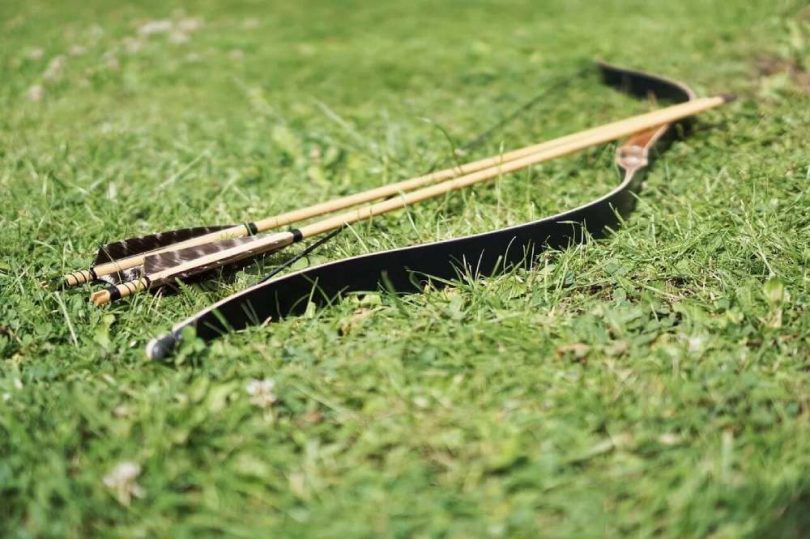







Leave a Comment